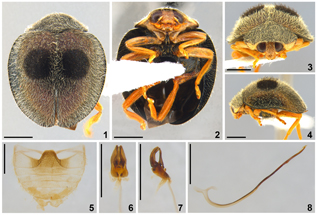Abstract
Zenoria Mulsant, 1850 (Coleoptera: Coccinellidae: Coccinellinae) is a Neotropical genus of lady beetles. Zenoria species are similar to species of Azyini in having a hairy dorsal surface with a black discal spot on each elytron formed by dark pubescence. Therefore, this paper provides an identification key for the two-spotted hairy lady beetles from South America, which include species of Azya Mulsant, Pseudoazya Gordon, and Zenoria. This paper also describes a new species, Zenoria candango Duarte-de-Mélo & Almeida sp. nov., from Brasília, Distrito Federal, Brazil. This is the 39th described species of Zenoria and the genus now comprises 18 species from Brazil.
References
Almeida L. M. 1995. A new species of Zenoria Mulsant from Brazil (Coleoptera: Coccinellidae). Journal of the New York Entomological Society 103(3): 324–328.
Blackwelder R. E. 1945. Checklist of the Coleopterous insects of Mexico, Central America, the West Indies, and South America. Bulletin of the United States National Museum 185: 1–188. https://doi.org/10.5479/si.03629236.185.3
Chapuis F. 1876. Famille des phytophages des érotyliens des endomychides et des coccinellides. Tomo 12. In: Histoire naturelle des insectes. Genera des Coléoptères (J. T. Lacordaire and F. Chapuis, editors). Paris, Roret, 424 pp. https://doi.org/10.5962/bhl.title.8864
Che L., Zhang P., Deng S., Escalona H. E., Wang X., Li Y., Pang H., Vandenberg N., Ślipiński A., Tomaszewska W. & Liang D. 2021. New insights into the phylogeny and evolution of lady beetles (Coleoptera: Coccinellidae) by extensive sampling of genes and species. Molecular Phylogenetics and Evolution 156: 107045. https://doi.org/10.1016/j.ympev.2020.107045
Crotch G. R. 1874. A revision of the coleopterous family Coccinellidae. E.W. Janson, London, xv + 311 pp.
Duarte-de-Mélo J., Basílio D. S., Lima I. M. M. & Almeida L. M. 2024. New species and identification key to species of Pseudoazya Gordon (Coleoptera: Coccinellidae: Azyini). Zoologia 41: 1–8. https://doi.org/10.1590/S1984-4689.v41.e23058
Gemminger M. & Harold B. 1876. Chrysomelidae (Par II.), Languridae, Erotylidae, Endomychidae, Coccinellidae, Corylophidae, Platypsyllidae. Família LXXII: Coccinellidae, Tom. 12, pp. 3740–3818. In: Catalogus Coleopterorum hucusque descriptorum synonymicus et systematicus (M. Gemminger and B. Harold, editors). Munich, Theodor Ackermann, 347 + lxxii pp. https://doi.org/10.5962/bhl.title.9089
Giorgi J. A., Vandenberg N. J., McHugh J. V., Forrester J. A., Ślipiński A., Miller K. B., Shapiro L. R. & Whiting M. F. 2009. The evolution of food preferences in Coccinellidae. Biological Control 51: 215–231. https://doi.org/10.1016/j.biocontrol.2009.05.019
González G. & Honour R. 2012. Tres nuevas especies del género Zenoria (Coleoptera: Coccinellidae) con diseño similar a Z. discoidalis (Kirsch). Boletín de la Sociedad Entomológica Aragonesa (S.E.A.) 50: 175–181.
Gordon R. D. 1971. A revision of the genus Zenoria Mulsant (Coleoptera: Coccinellidae). Smithsonian Contributions to Zoology 86: 1–22. https://doi.org/10.5479/si.00810282.86
Gordon R. D. 1972. Additional notes on the taxonomy of the genus Zenoria (Coleoptera: Coccinellidae). Proceedings of the Entomological Society of Washington 7(4): 433–442.
Gordon R. D. 1980. The tribe Azyini (Coleoptera: Coccinellidae): historical review and taxonomic revision. Transactions of the American Entomological Society 106(2): 149–203.
Gordon R. D. 1981. Lectotype designations, generic reassignments, and new synonymy in Neotropical Coccinellidae (Coleoptera). The Coleopterists Bulletin 35(4): 423–425.
Gordon R. D. 1996. South American Coccinellidae (Coleoptera). Part III: Correction and addition. Entomological News 107: 232–232.
Gorham H. S. 1887–1899. Coleoptera Vol. VII: Erotylidae, Endomychidae and Coccinellidae, pp. 160–265. In: Biologia Centrali-Americana, or contributions to the knowledge of the fauna and flora of Mexico and Central America (F. D. Godman and O. Salvin, editors). London, R. H. Porter, xii + 276 pp. + 13 pls.
Guedes C. F. C. 2013. Preferência alimentar em Coccinellidae. Oecologia Australis 17(2): 249–270.
Korschefsky R. 1931. Pars 118: Coccinellidae. I. In: Coleopterorum Catalogus (W. Junk and S. Schenkling, editors). Berlin, pp. 1–225.
Mulsant E. 1850. Species des Coléoptères trimères sécuripalpes. Annales des Sciences Physiques et Naturelles d’ Agriculture et d’ Industrie, Lyon 2(2): 1–1104. https://doi.org/10.5962/bhl.title.8953
Poorani J. & Ślipiński S. A. 2009. A revision of the genera Scymnodes Blackburn and Apolinus Pope et Lawrence (Coleoptera: Coccinellidae). Annales Zoologici 59(4): 549–584. https://doi.org/10.3161/000345409X484946
Poorani J. & Ślipiński S. A. 2010. A review of Rhynchortalia Crotch (Coleoptera: Coccinellidae: Ortaliinae). Zootaxa 2423: 25–43. https://doi.org/10.11646/zootaxa.2423.1.2
Pope R. D. & Lawrence J. F. 1990. A review of Scymnodes Blackburn, with the description of a new Australian species and its larva (Coleoptera: Coccinellidae). Systematic Entomology 15(2): 241–252. https://doi.org/10.1111/j.1365-3113.1990.tb00315.x
Samways M. J., Osborn R. & Saunders T. L. 1997. Mandible form relative to the main food type in ladybirds (Coleoptera: Coccinellidae). Biocontrol Science and Technology 7: 275–286. https://doi.org/10.1080/09583159730974
Santos P. B. 2014. Filogenia do gênero Neotropical Zenoria Mulsant, 1850 (Coleoptera, Coccinellidae, Ortaliinae) [Master’s thesis, Universidade Federal do Paraná]. Acervo Digital da Universidade Federal do Paraná.
Santos P. B. & González G. 2016. New species of Zenoria Mulsant (Coleoptera: Coccinellidae) from Brazil and Peru. Zootaxa 4205(4): 386–394.
Senna L. F. N., Zacarias M. S., Bueno V. H. P. & Moraes, J. C. 1997. Aspectos biológicos de Zenoria roberti (Coleoptera, Coccinellidae) sobre a cochonilha Planococcos citri (Homoptera, Pseudococcidae). Resumos XVI Congresso Brasileiro de Entomologia: 79.
Ślipiński A. 2007. Australian ladybird beetles (Coleoptera: Coccinellidae): their biology and classification. Department of the Environment and Water Resources, Canberra, 286 pp.


